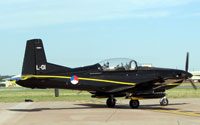|

|
|

|
The Pilatus
PC-7 Turbo Trainer is a low-wing tandem-seat training aircraft,
manufactured by Pilatus Aircraft of Switzerland. The aircraft is
capable of all basic training functions including aerobatics,
instrument, tactical and night flying.
The PC-7 is
based on the earlier piston-powered Pilatus P-3. The first prototype
(manufactured from a modified P-3) flew on 12 April 1966, but after a
crash the PC-7 programme was shelved.
In 1973 the programme was restarted and another P-3 was obtained from
the Swiss Air Force. After modification, this aircraft flew on 12 May
1975. Further extensive modifications followed later in the programme,
including a new one-piece wing with integral fuel tanks, an altered
tailfin and a bubble canopy.
The first production aircraft flew on 18 August 1978. Swiss civil
certification followed on 5 December of the same year, with deliveries
starting immediately thereafter.
The PC-7 Mk II is a development of the PC-9's airframe and avionics,
fitted with the PC-7's smaller turbine to lower operating and
maintenance costs. It is used by the South African Air Force, with
sixty examples having been manufactured. The aircraft were assembled
in South Africa from kits supplied by Pilatus. The value of the
contract was estimated to be USD 175 million in 1993. Four PC-7 Mk II
aircraft are used by the air force of Brunei.
The aircraft is also used by private customers and is both FAA and
FOCA civil certified in order to comply to the general aviation
regulations in Europe and the USA.
|
PC-7 Specifications |
|
Type |
Basic Trainer |
|
Manufacturer |
Pilatus
Aircraft |
|
Accommodation |
Two (student and
instructor) |
|
Armament |
Six hard points for bombs and rockets |
|
Performance |
Max
speed 290 mph (460 km/h) |
|
Wing Span |
33ft (10m) |
|
Length |
33ft (10m) |
|
Height |
10ft 10in (3.3m) |
|
Weight |
empty weight 3,680lb (1,670kg), max take off
weight 5,900lb(2,500kg) |
|
Powerplant |
One Pratt & Whitney Canada PT6A-25C, producing
700 shp (522 kW) |
|